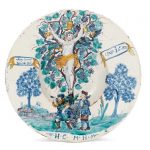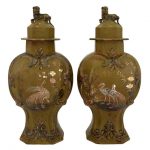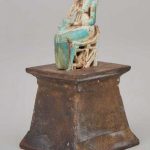Faience. The term faience broadly encompassed finely glazed ceramic beads, figures and other small objects found in Egypt as early as 4000 BC, as well as in the Ancient Near East, the Indus Valley Civilisation and Europe. However, this material is not pottery at all, containing no clay, but a vitreous frit, either self-glazing or glazed. The Metropolitan Museum of Art displays a piece known as “William the Faience Hippopotamus” from Meir, Egypt, dated to the Twelfth Dynasty of Egypt, c. 1981–1885 BC. Examples of ancient faience are also found in Minoan Crete, which was likely influenced by Egyptian culture. Faience material, for instance, has been recovered from the Knossos archaeological site.
It is also the conventional name in English for fine tin-glazed pottery on a buff earthenware body, at least when there is no more usual English name for the type concerned. The invention of a white pottery glaze suitable for painted decoration, by the addition of an oxide of tin to the slip of a lead glaze, was a major advance in the history of pottery. The invention seems to have been made in Iran or the Middle East before the ninth century. A kiln capable of producing temperatures exceeding 1,000 °C (1,830 °F) was required to achieve this result, the result of millennia of refined pottery-making traditions. The term is now used for a wide variety of pottery from several parts of the world, including many types of European painted wares, often produced as cheaper versions of porcelain styles.
English generally uses various other terms for well-known sub-types of faience. Italian tin-glazed earthenware, at least the early forms, is called maiolica in English, Dutch wares are called Delftware, and their English equivalents English delftware, leaving “faience” as the normal term in English for French, German, Spanish, Portuguese wares and those of other countries not mentioned (it is also the usual French term, and fayence in German). The name faience is simply the French name for Faenza, in the Romagna near Ravenna, Italy, where a painted majolica ware on a clean, opaque pure-white ground, was produced for export as early as the fifteenth century. Reference: Wikipedia
A Central European faience charger, dated 1680 Possibly Bohemian or Moravian, of large size, painted in blue, manganese, ochre and turquoise-green with a fruiting vine tree merged with the image of the Crucifixion, three angels in the branches of the tree holding goblets to catch the blood from The Saviour’s wounds, two men at the base of the tree holding between them a pole hung with a large bunch of grapes, a townscape and other trees in the distance, the image flanked by banderols inscribed ‘Anno Domini natñiate Jesu’ Chriße 16.80′, the initials H.C and M.H inscribed at the base of the dish, 36.2cm diam
Sold for £ 5,000 inc. premium at Bonhams in 2019
Faience perfume-vase in the form of a fish. Archaic Greek Date 7th Century BC-6th Century BC
Reference: © The Trustees of the British Museum
AN EGYPTIAN FAIENCE SHABTI FOR NEFERIBRE-SANEITH LATE PERIOD, 26TH DYNASTY, CIRCA 6TH CENTURY B.C. 7 ½ in. (19.1 cm.) high
Sold for USD 50,000 at Christies in 2019
Pair of Berlin Faience Garniture Vases and Covers Mid-19th century Each of baluster form and decorated with chinoiserie motifs on a green gound, the underside with unrecorded maker’s stamp. Height 19 3/4 inches (50.2 cm), width 9 1/2 inches (24.2 cm), depth 8 inches (20.3 cm).
Sold for $1,625 (includes buyer’s premium) at Doyle New York in 2019
Egyptian Blue Glazed Faience Amulet of a Lion Headed Goddess, Third Intermediate Period, 1070-664 B.C. possibly Sakmmet, Bastet or Wadjet depicted seated on openwork throne, on later ebonized base figure height 2.1″ — 5.4 cm.; 4″ — 10.2 cm.
Sold For CA$550 at Waddington’s Auctioneers and Appraisers in 2019
This type of colored faience tile was used to decorate the royal palaces of the New Kingdom. The foreign captive chosen as the subject here evokes the dominion the pharaoh was said to exercise over the rest of the known world, as one of his mythical attributes. At the same time, the motley garments of such foreigners provided a pretext for a colorful and exotic decorative scheme.
Captured in faience A bearded man is depicted in the posture of a vanquished enemy, down on one knee, with right shoulder turned away and hands tied behind his back. He wears a pleated robe with much colored braid, and from his neck hangs a disk pendant, an item of jewelry characteristic of the peoples of the Syria-Palestine region in the 2nd millennium BC. Together with his fine black beard, these details identify him as being from those lands. The tile is made of faience, a quartz-based ceramic, and has a colored glaze. The method of production was particularly elaborate: the different elements of the body, whose details are picked out in paint, were modeled in low relief and then applied to a common base. The section with the hair has been lost after coming loose.
Reference:The Louvre








